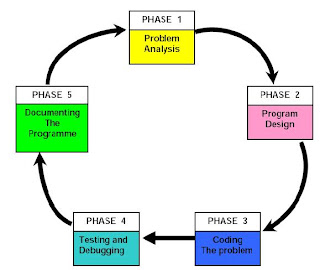five main phases in program development;
 Let’s look at the descriptions of each main phase in program development:
Let’s look at the descriptions of each main phase in program development:1. Problem Analysis
What is problem analysis?
You need to identify the problem before developing a program. Let’s imagine
that you are a programmer.
As a programmer, you are contacted because your services are needed. You
meet with users from the client organization to analyze the problem, or you meet
with a systems analyst who outlines the project. Specifically, the task of defining
the problem consists of identifying what it is you know (input-given data), and
what it is you want to obtain (output-the result). Eventually, you produce a written
agreement that, among other things, specifies the kind of input, processing, and
output required. This is not a simple process.
2. Program Design
In this phase, you will do the following tasks :-
• Plan the solution to the problem (think about how will you solve the problem)
• Choose the interface (think about how will your program look like)
3. Coding
So now you are ready to write the code of the program that you have planned.
You need to express your solution in a programming language.
The normal process you will go through is to translate the logic from the flowchart
or pseudocode-or some other tool-to a programming language.
As we have already noted, a programming language is a set of rules that
provides a way of instructing the computer what operations to perform. There
are many programming languages: BASIC, COBOL, Pascal, FORTRAN, and
C are some examples. You may find yourself working with one or more of
these. However in this module, we will either produce a program using
Microsoft VB-express or Just BASIC v1.01.
Although programming languages operate grammatically, somewhat like the
English language, they are much more precise. To get your program to work,
you have to follow exactly the rules-the syntax-of the language you are using.
Of course, using the language correctly is no guarantee that your program
will work, any more than speaking grammatically correct English means you
know what you are talking about. The point is that correct use of the language
is the required first step. Then your coded program must be keyed, probably
using a terminal or personal computer, in a form the computer can
understand.
One more note here: Programmers usually use a text editor, which is
somewhat like a word processing program, to create a file that contains the
program. However, as a beginner, you will probably want to write your
program code on paper first.
4. Testing and Debugging
The fourth phase is to test and debug your program.
Why do you need to test?
The imperfections of the world are still with us, so most programmers get used to
the idea that their newly written programs probably have a few errors. This is a
bit discouraging at first, since programmers tend to be precise, careful, detailoriented
people who take pride in their work.
Still, there are many opportunities to introduce mistakes into programs, and you,
just as those who have gone before you, will probably find several of them.
Why debug?
You need to debug to improve your program. Debug is a term used extensively
in programming. “Debugging” means detecting, locating, and correcting bugs
(mistakes), usually done by running the program.
These bugs are logic errors, such as telling a computer to repeat an operation
but not telling it how to stop repeating. In this phase you run the program using
test data that you devise. You must plan the test data carefully to make sure you
test every part of the program.
How do you debug?
You can carry out debugging by running the program. The following are
examples of debugging for Visual Basic Express and Just BASIC.
a. debugging button in Visual Basic Express

5. Documentation
Documentation is important when programming. Documenting is an ongoing,
necessary process, although, as many programmers are, you may be eager to
pursue more exciting computer-centered activities.
What is documentation?
Documentation is a written detailed description of the programming cycle and
specific facts about the program. Typical program documentation materials
include the origin and nature of the problem, a brief narrative description of the
program, logic tools such as flowcharts and pseudocode, data-record
descriptions, program listings, and testing results.
Comments in the program itself are also considered an essential part of
documentation. Many programmers document as they code. In a broader sense,
program documentation can be part of the documentation for an entire system.
The wise programmer continues to document the program throughout its design,
development, and testing. Documentation is needed to supplement human
memory and to help organize program planning. Also, documentation is critical to
communicate with others who have an interest in the program, especially other
programmers who may be part of a programming team.
Written documentation is needed in computer industry so that those who come
after you can make any necessary modifications in the program or track down
any errors that you missed.
